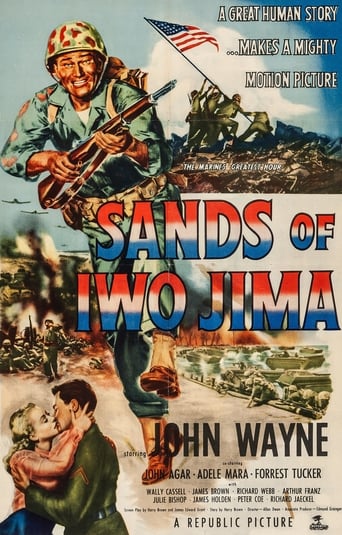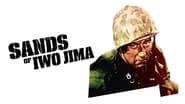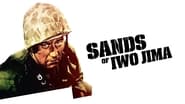James Hitchcock
"Sands of Iwo Jima" is a patriotic war film of the type that was popular (in both America and Britain) in the years following the end of World War II. Although the war itself had been over for four years when it was made, by 1949 the Cold War had started, and the thought that America might soon be at war again may have been a factor in the popularity of films of this sort. It is notable that few patriotic war films were made in the immediate aftermath of World War I when it was widely, if erroneously, believed that the horrors of the trenches had made war a thing of the past; anti-war films were more popular during this period. Like a number of such films it follows a group of fighting men- in this case a squad of United States Marines- through the war, typically starting with their training and ending with some heroic engagement in which the unit acquit themselves with distinction. The engagement in this case is the famous Battle of Iwo Jima of February/March 1945 in which American forces succeeded in seizing control of a Japanese-held island, albeit at the cost of heavy casualties. A photograph of US Marines raising the Stars and Stripes over the island became an icon of American patriotism; this event is recreated in the film making it a "flag-waving" movie in the most literal sense. (The value of this victory has been doubted. It has been pointed out that Iwo Jima had little strategic value and that, given their overwhelming superiority in numbers and their complete control of the surrounding sea and air, it would have been virtually impossible for the Americans to have lost the battle. Needless to say, doubts of this nature are never raised in the film). We first meet the squad during training in New Zealand, where they are being put through their paces by tough-but-fair Sergeant John Stryker. Not all the men, however, appreciate Stryker's rigorous training methods. He is especially disliked by two of them. Private Al Thomas, who has tangled with Stryker in the past, regards him as tough-but- unfair. Private Peter Conway, who has joined the Marines for the sake of family tradition rather than out of any genuine enthusiasm, loathes him for more complicated reasons. Conway's father, who has been killed earlier in the war, was himself an officer in the Marines. Stryker served under him and greatly admired him, but Conway junior despised his father, whom he saw as cold and unfeeling, and transfers his hatred to Stryker, whom he sees as a man of a similar stamp. Needless to say, both Thomas and Conway eventually prove themselves heroes when the squad go into battle. A subplot deals with Conway's courtship of, and marriage to, Allison, a New Zealand girl. (At least, I presume Allison is a New Zealander, although Adele Mara plays her with an American accent). An attempt is made to give Stryker himself some sort of a back-story; we learn that he went through a traumatic divorce before the war and that he has become an alcoholic as a result. The scriptwriters, however, seem to regard his tendency to drink alcohol to excess as a mere personal foible which in no way detracts from his efficiency as a soldier. When his squad come across him dead drunk in the street they all- even those who dislike him- combine to hide him and protect him from the military police, never stopping to think whether a habitual drunkard is really the sort of man they want to lead them in combat. Today the battle scenes would seem fairly feeble, not only in comparison with something like "Saving Private Ryan" but also in comparison with later war films from the sixties and seventies. In the late forties, however, they probably seemed effective enough and aroused greater tension than comparable films made during the war itself. The casting of John Wayne, who himself had never served in the armed forces and was considered a draft dodger by some, was controversial, but the film nevertheless brought him his first Academy Award nomination for "Best Actor in a Leading Role". Wayne had a limited range as an actor, but could be very good within that range, as he is here, making Stryker entirely credible as a man whom others would willingly follow into battle, despite his personal weaknesses. He lost out on "Best Actor", however, to Broderick Crawford as Governor Stark in "All the King's Men"; ironically this was a role which Wayne himself had been offered but refused. "Sands of Iwo Jima" is a "Marmite Film" that will continue to divide opinion, even more than sixty years after it was made. Pacifists will doubtless hate it as a glorification of war. American patriots, especially those who share John Wayne's conservative politics, will love it as a celebration of heroism in a just cause. It is, however, overall a well-written, well-acted and generally well-made picture of men at war, if rather too gung-ho for my tastes. 7/10
SanteeFats
This is a very well done movie. The casting is excellent, the acting is very good, and the action is well done. A tough, hard bitten sergeant trains his men for combat, during which he beats down a rebellious private, teaches a recruit to do the bayonet drill by dancing with him, and then leads them into battle. John Agar plays a career officers rebellious brat who enlisted and actually comes of age on Mount Surabachi. Unfortunately he does this after the sergeant is killed by a hidden sniper. I admit that I found the last scene a little hard emotionally as John Wayne is shot while he was reading a letter about his son. Earlier in the movie he went back to a women's place, obviously for a sexual liaison, found her child crying in the crib and threw down all his money so the baby could eat. This was a touching scene for me also.
dbdumonteil
"Sands of Iwo Jima " is a good war movie ,unlike Wayne's own "green berets" in the sixties .It is one of his most moving parts .The tough sarge (not so tough,by the way, if you compare it to the military men in "take the high ground" or "from here to eternity")is actually a wounded man in search of a family (as the hero of "the searchers" was) and mainly of a child .His wife took away his boy from him and now he is desperately in need of love and affection (the final letter may be one of the most poignant I've ever heard).His hatred for Conway is actually close to affection;this educated young man represents all he has lost .Another significant scene is the moment when Wayne visits a woman and her baby and gives her/him all his pay.Conway has also a baby and he does not want him to become a marine like him or his grandfather (whose shadow hangs over all the movie ,since he was Conway's father and his sarge's officer).The scene at night on the island when a voice is calling in the darkness is gripping .To be recommended .
John T. Ryan
SOMEWHERE we recall seeing a review of the John Wayne starring vehicle, THE GREEN BERETS (Batjac Prod./Warner Bros.1968), which of course panned the picture as "applying World War II, SANDS OF IWO JIMA logic" to the (then) current Viet-Nam War and the involvement of Uncle Sam in it. WELL, Mr. Big Shot Movie Guy, we hate to disagree with your high level, cerebral and virtually error-free edicts; but the SANDS Picture was actually made in the post-war period; and may well have been one of the first movies of any stature to pay tribute to the great sacrifices given up by so many ordinary citizens, who were made into Wartime Leathernecks.WHEN we say "movies of any stature", we most usually would not be referring to any usual product of that Republic Outfit at 4024 Radford Avenue, Studio City, Los Angeles, California. Their output was more that of their famous assembly-line operation; not unlike those found in the old Chicago Stock Yards and the Ford Motor Company in Detroit. Although they came up with an occasional gem, such as Lewis Milestone's THE RED PONY (1949) and John Ford's THE QUIET MAN (1952), which many believe to have been Republic's finest moment. (Arguably).MORE familiar to the company was production of fodder for the Saturday Afternoon Matinée crowd, the kiddy crowd. The genres found plentiful in the yearly out-put were the Series or "B" Western and the Movie Chapter Play Serial/Cliff-Hanger; with the occasional Family-type Comedy thrown in, such as THE ATOMIC KID (Mickey Rooney Prod./Republic,1954) with Mickey Rooney and Robert Strauss.ACTION being a top ingredient of the real, Wartime made war pictures; one would think that Republic would be more than up to the task of bringing the world some "realistic" tales of the battles raging in Western Europe, North Africa, Southeast Asia, Russia, China-Burma-India and the South Pacific. After all, we see plenty of top rate action in FLYING TIGERS (Republic, 1942) and the SPY SMASHER Serial(Republic,1942); but also we have generous helpings of Anti-Nazi, Anti-Fascist and Anti-Imperial Japanese Militarist wartime propaganda woven through-out. We also know that 'propaganda' isn't necessarily a bad thing.* SANDS OF IWO JIMA, on the other hand, is not nor was it ever intended to be any such a sort of movie. As we previously mentioned, we believe that SANDS may well have been the first film to begin to deal with asking ourselves just what happened, what price did both those who died as well as those who survived pay and how we were blessed with a victory; preserving our freedoms for a new generation.WHEREAS the inherent brutality of combat in modern warfare was depicted in the fine battle scenes filmed, any sort of what might be considered to be politically incorrect remarks concerning "the Japs" are held to a minimum, if not excised completely.PROPERLY and in extremely good taste, the picture sticks to the very 'over-soul' of that organization we know as the United States Marine Corps and how a young man would relate to and get along as a member of it. Pride, History and Tradition all play a major role in the story. Told in an almost metaphorical tale from the points of view of the characters Sgt. Stryker (John Wayne), Pvt. Peter Conway (John Agar), Allison Bromley (Adele Mara-Woo,woo,woo,woo!), Pfc. Al Thomas (Forrest Tucker) and Mary (Julie Bishop), the tale becomes that of almost anyone from that strife-torn era. The usual collection of ethnic types and regional U.S. accents are represented; being in the capable hands of a great group of supporting repertory players such as: Wally Cassell, James Brown, Richard Webb, Arthur Franz, James Holden, Peter Coe, a young Richard Jaeckel, an even younger Martin Milner and others.INCLUDED in the film are many true-life Marine Heroes who lived the parts portrayed in the story; often as Officers and others with speaking roles. Of particular interest is the inclusion of Marine Pfc.'s Rene Gagnon, Ira H. Hayes and John H. Bradley; who are seen re-enacting their parts in raising the Stars & Stripes over Mt. Suribachi, signifying the victory over the Imperial Japanese forces on that atoll.IN paying proper tribute to the Republic Production crew and to Director Alan Dwan, we must mention the finely staged and filmed action scenes. The recreations of 'hitting the beach' in SANDS were exceptional; only being surpassed with Darryl F. Zanuch's THE LOMGEST DAY (1962). There was excellent use made of inter-cutting real Pacific Island battle footage with the movie scenes and the editing was overall, nearly flawless.RATHER than the rather smug and narrow-minded assessment of the film by the above mentioned Mr. Big Shot Movie Reviewer, we feel that SANDS OF IWO JIMA should go down in history as a great memory and tribute to our Fighting Marines in World War II from Hollywood, as well as its being possibly Republic Pictures finest hour. (Once again, Arguably).NOTE: * The word PROPAGANDA has long been viewed as a sort of 'dirty' word. This is due mainly to the usage is most often tied in with the activity of our enemies. We have grown accustomed to hearing of "Nazi Propaganda", "Communist Propaganda", "Feminist Propaganda", etc. But we all propagandize in order to get out our message and spread the word for our side, the American Way. A Plant Nursery will propagate a flower by planting its seeds and harvesting a far greater number than before. Even the Catholic Church has its Society for the Propagation of the Faith. (Just kidding about that "Feminist Propaganda" remark, Ladies!)








